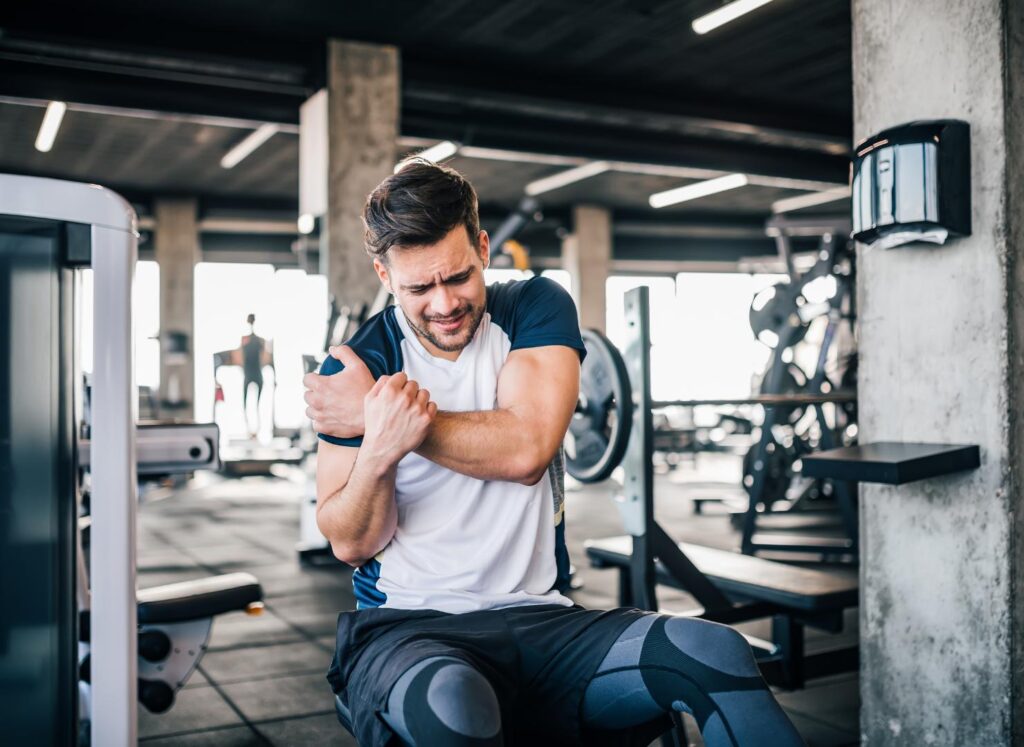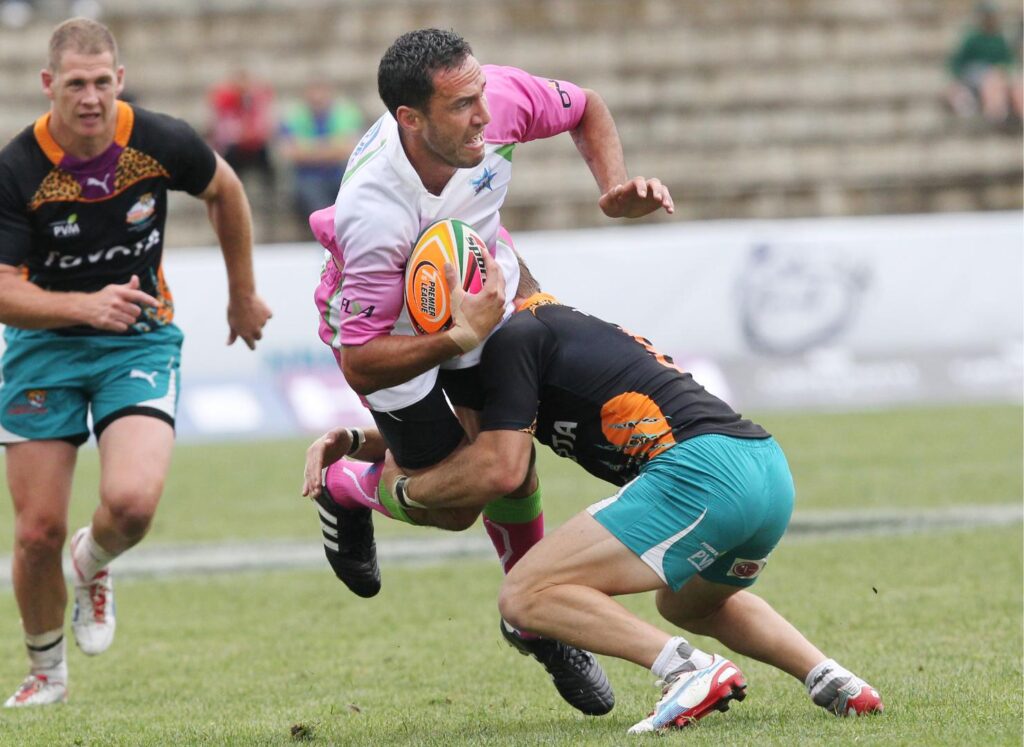Are you feeling a sharp pain in your shoulder, making it hard for you to move? If raising your arm, reaching for something, or even getting dressed feels like a struggle, you might be dealing with an AC joint injury.
Whether you’re a rugby player taking heavy tackles, a weightlifter pushing limits, or just someone who took an awkward fall, AC joint injuries can be painful and frustrating. But what exactly is an AC joint injury, and how can you recover effectively?
In this blog, we’ll break down everything you need to know about shoulder AC joint injury—what causes it, how to spot the symptoms, and the best AC joint injury treatments to get you back to full strength.

Table of Contents
What is an AC joint?
Your acromioclavicular (AC) joint is the small but important joint where your collarbone (clavicle) meets your shoulder blade (scapula). It plays a key role in moving your shoulder by helping you lift, reach, and rotate your arm.
Every time we move, our AC joint is also at work. It’s often the first to absorb the impact from falls, collisions, or repetitive strain, making it highly prone to injury. Whether you’ve taken a hard hit in rugby, landed awkwardly from a fall, or simply overworked your shoulder, this joint can take quite a beating.
Now that you know what the AC joint is, let’s look at how injuries happen and what symptoms to watch out for.
Anatomy of the shoulder showing normal ligaments (Source: Koehler, et. al., 2024)
How does an AC joint injury happen?
If you play rugby, football, or other high-contact sports, you’ve probably seen (or experienced) an AC joint injury before. It’s one of the most common shoulder injuries among athletes, especially in collision-heavy sports.
Research backs this up. A five-year study by Usman et.al (2015) found that among elite male rugby players, there were 13 shoulder injuries per 1,000 player hours, with AC joint injuries being the most frequent. Another study by Headey, et.al. (2007) confirmed that AC joint injuries made up 32% of all shoulder injuries in rugby matches, with 65% of them caused by tackles.

So, what exactly causes an AC joint injury?
A direct blow to the shoulder is often the main cause—like from a hard tackle, a bad fall, or even landing awkwardly on an outstretched arm. These sudden impacts put extreme force on the joint, which can lead to sprains, separations, or even fractures.
Now that we know how these injuries happen, let’s talk about what symptoms to look out for.
What are the symptoms of an AC joint injury?
When an AC joint injury occurs, you may feel a sharp and intense pain at the top of your shoulder. But pain is just one symptom and depending on its severity, it can lead to mild sprains or complete shoulder dislocations.
The Rockwood classification system is the most widely used method to diagnose AC joint injuries, as it breaks them down into six types, depending on how severe the injury is:

Knowing the severity of your AC joint injury can help determine the right treatment and recovery plan.
For mild injuries like Types I and II, rest and physiotherapy usually do the trick. But for more severe types, like Type III to VI, surgery might be needed for a full recovery. If you think you’ve injured your AC joint, it’s important to get a professional assessment and treatment to avoid long-term issues.
To help visualise each type of AC joint injury, check out this illustration that highlights the differences between Types I – VI.
How AC Joint Injuries Progress: Types I-VI Illustrated. Source: Gobarty, et.al. (2016)
Diagnosing an AC joint injury
So, you’re experiencing sharp pain in your shoulder, and you’re wondering if it could be an AC joint injury? The first step is to have it properly assessed. A sports physiotherapist is your go-to expert when it comes to identifying AC joint injuries.
During your appointment, they’ll start by performing a physical examination, checking for tenderness, and evaluating your shoulder’s range of motion. This is important to understand how much of your movement is affected and pinpoint any areas of concern.
To get a clearer picture of your injury’s severity, your physiotherapist may recommend an X-ray. This helps to rule out fractures and provides a better understanding of how badly your AC joint is injured.
How do we treat an AC joint injury?
Once your injury is diagnosed, your physiotherapist will guide you through the best treatment plan based on the severity of your AC joint injury. For mild injuries, like Types I and II, rest and physiotherapy are typically enough to get you back on track. These treatment options focus on relieving pain, reducing inflammation, and gradually restoring your shoulder’s function.
However, if your injury falls into the more severe categories, like Types III to VI, surgery may be necessary for full recovery. Surgery could be required if there’s significant damage to the ligaments, or if the clavicle has shifted out of place in a way that impairs normal function. In any case, your physiotherapist will work closely with you to determine the most appropriate recovery plan tailored to your needs.
Whether your injury is mild or severe, following your physiotherapist’s treatment recommendations and staying committed to your recovery plan will help you to heal and recover faster.

5 Best Recovery Tips to Heal from your AC Joint Injury
Recovering from an AC joint injury isn’t just about resting and waiting for the pain to go away. It’s a gradual process that requires a mix of rest, strengthening, and carefully planned rehabilitation exercises.
Here are five key tips to help you get back to full strength in your shoulder:
1. Engage in gentle mobility exercises
Starting with mild range-of-motion exercises is key to keeping your shoulder joint mobile and flexible. It helps prevent stiffness and ensures that you’re not overloading your healing tissue.
2. Strengthen gradually
Once the pain starts to subside, strengthening exercises will help restore your muscle function around the shoulder. But remember, it’s important to stop if you feel pain as pushing despite your discomfort can delay your recovery.
3. Follow your physiotherapist’s advice
Your physiotherapist will create a rehabilitation program specifically for your injury. Make sure to stay committed throughout your program to achieve the best chance of recovery.
4. Go for easy, but consistent physical activities
Rushing into sports or heavy physical activity can make things worse. Give your shoulder time to fully heal before jumping back into anything intense.
5. Prioritise rest and recovery
Don’t forget the power of rest! Recovery isn’t just about exercise; it’s about allowing your body time to heal properly, especially during the early stages.
By staying consistent with your rehabilitation and avoiding unnecessary strain, you’ll be back to full strength in no time. Remember, every AC joint injury is different, so take it one step at a time and listen to your body.
When to Consult a Physiotherapist
If you experience persistent shoulder pain, notice a deformity, or have difficulty moving your arm after an injury, it’s important to see a physiotherapist as soon as possible. An experienced physiotherapist can assess the severity of your injury, recommend the right treatment plan, and guide you through your rehabilitation process, ensuring you recover as quickly and safely as possible.
Final Thoughts
Recovering from an AC joint injury takes time and patience, but with the right treatment and rehabilitation, you can return to your normal activities without lasting issues. Our team at Rehab Lab Physiotherapy is here to guide you every step of the way, to give you the best care and treatment plan.
Let’s help you get back to doing what you love.
Book an appointment with us today and let’s work together to start your recovery!
References:
Gorbaty, Jacob D., Hsu, Jason E., Gee, Albert O. (2016). Classifications in Brief: Rockwood Classification of Acromioclavicular Joint Separations. Clinical Orthopaedics and Related Research, 475(1):283-287. https://doi.org/10.1007/s11999-016-5079-6
Headey, Julia, Brooks John H., Kemp, Simon P. (2007). The epidemiology of shoulder injuries in English professional rugby union. Am J Sports Med, 35(9):1537-43. https://doi.org/10.1177/0363546507300691
Koehler, Scott M., Fields, Karl B., and Grayzel, Jonathan S. (2024). Patient education: Acromioclavicular joint injury (shoulder separation) (Beyond the Basics). UpToDate. https://www.uptodate.com/contents/acromioclavicular-joint-injury-shoulder-separation-beyond-the-basics/print
Usman, Juliana, McIntosh, Andrew S., Quarrie, Kenneth, Targett, Stephen. (2015). Shoulder injuries in elite rugby union football matches: Epidemiology and mechanisms. Journal of Science and Medicine in Sport, 18 (5), 529-533. https://doi.org/10.1016/j.jsams.2014.07.020


